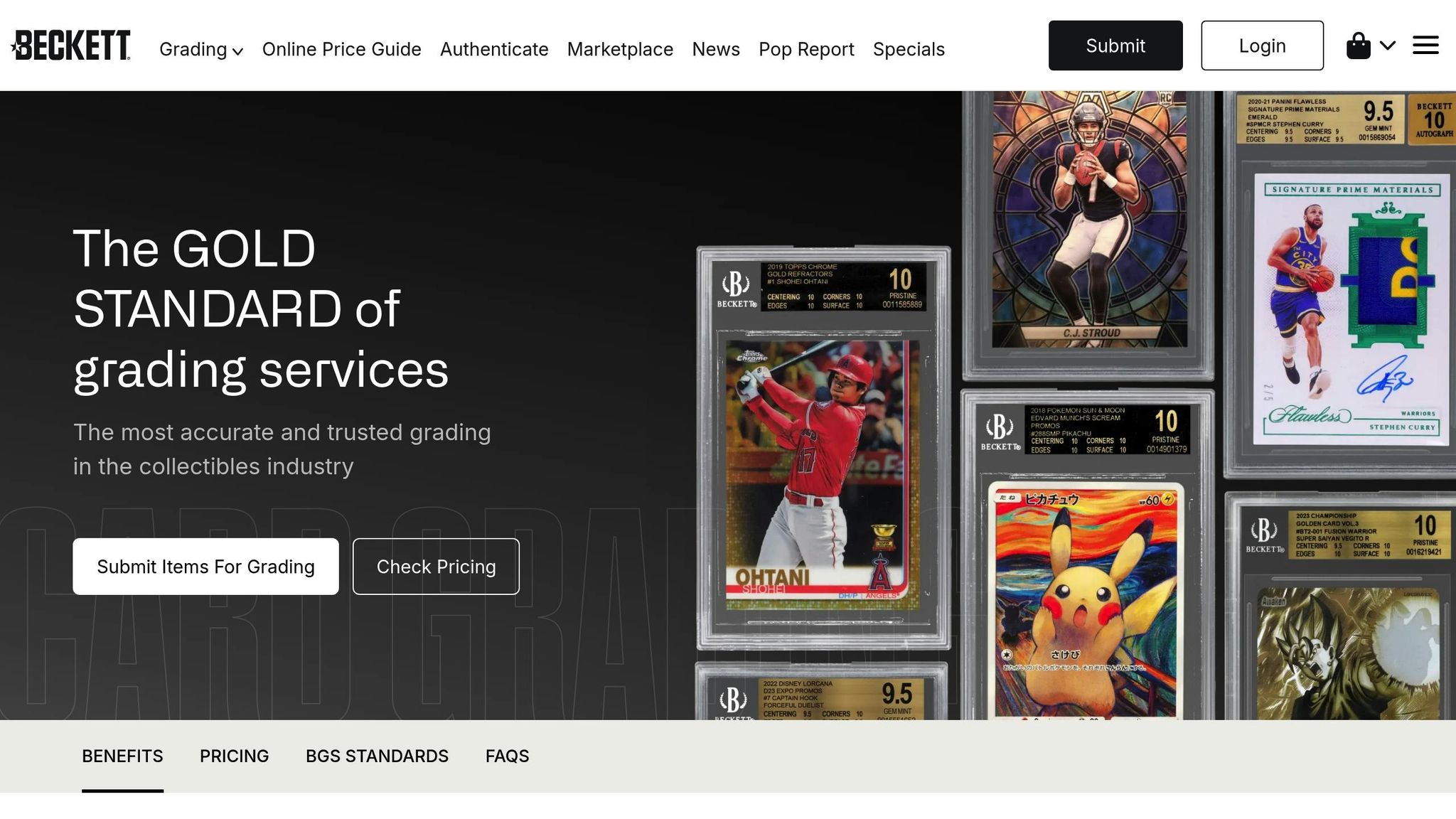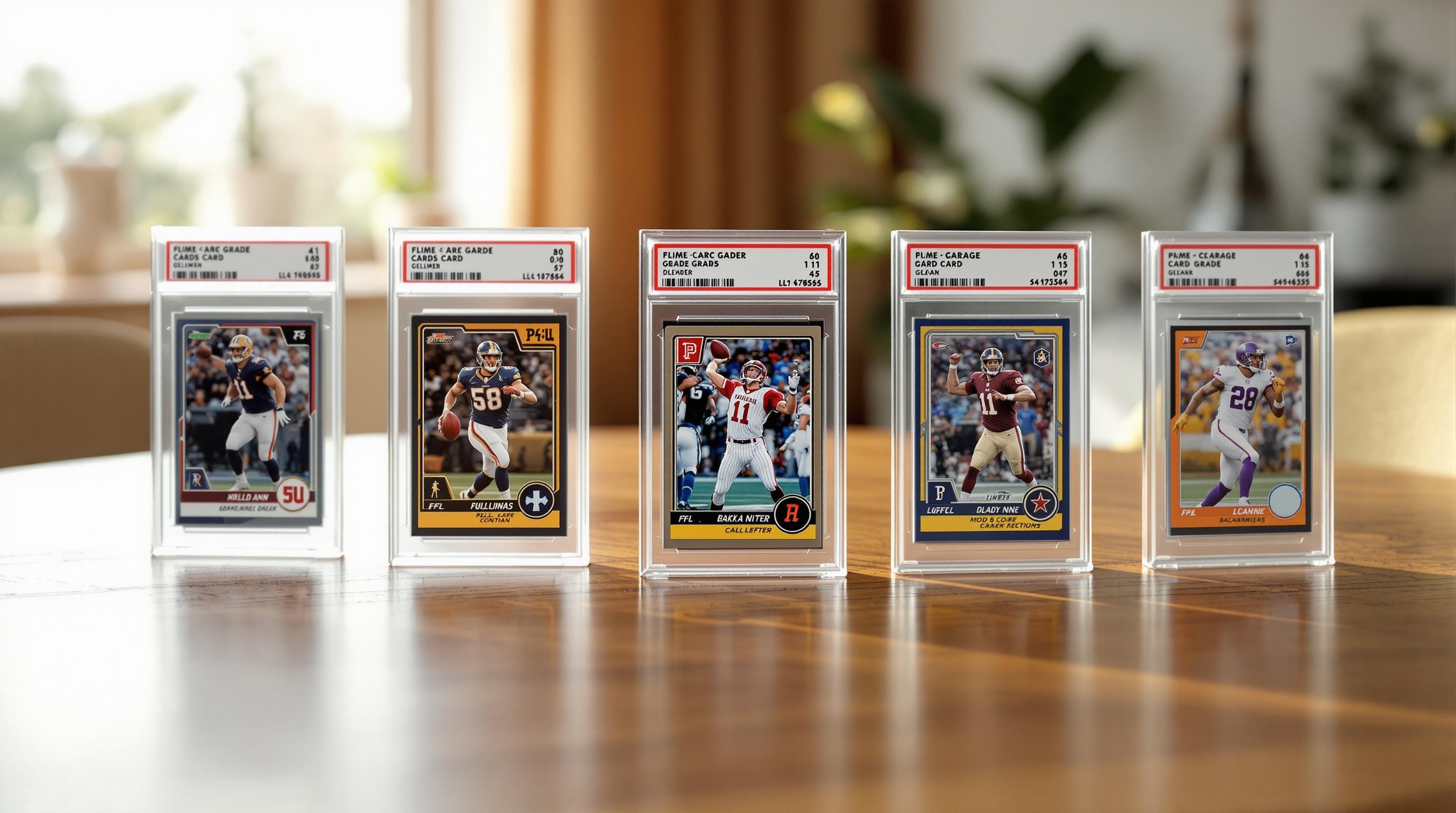PSA and BGS are the two most trusted card grading companies, but they serve different needs. PSA is preferred for vintage cards and offers higher resale potential due to its strong brand recognition. BGS excels with modern cards, thanks to its detailed subgrade system, which provides a breakdown of card quality. Both companies increase card values, but your choice depends on your goals, card type, and priority for resale speed or grading detail.
Key Takeaways:
- PSA: Best for vintage cards; simpler grading scale (1-10); higher market demand; faster sales.
- BGS: Ideal for modern cards; includes subgrades (centering, corners, edges, surface); stricter grading; slower but potentially higher resale prices.
Quick Comparison:
| Factor | PSA | BGS |
|---|---|---|
| Grading Scale | 1-10 (no subgrades) | 1-10 with detailed subgrades |
| Market Demand | Higher for vintage cards | Strong for modern cards |
| Resale Speed | Typically faster | Often slower |
| Top Grade | PSA 10 Gem Mint | BGS 10 (Pristine/Black Label) |
| Best for | Vintage sports cards | Modern and autographed cards |
Choosing the right service depends on your card type, goals, and timeline. PSA is better for quick sales and vintage cards, while BGS appeals to collectors valuing detailed grading and modern card precision.
Should you grade your cards at BGS vs PSA? (Breaking down price, value-add and more.)

PSA Grading Standards and Market Effects
For over three decades, PSA has been a cornerstone of the trading card market, setting grading standards that collectors trust and recognize. Its grading system and brand reputation play a key role in driving premium resale values.
PSA's 1-10 Grading Scale
PSA uses a simple 1-10 grading scale to evaluate a card's overall condition. A PSA 10, or Gem Mint, represents a nearly flawless card with sharp corners, excellent centering, and no visible defects. A PSA 9, or Mint, may have only minor imperfections. Cards graded PSA 8 or PSA 7 show more noticeable flaws but are still considered to be in good condition. This straightforward scale makes it easy for buyers to quickly understand a card's quality. Beyond the clarity of the grading system, PSA's reputation amplifies the value of its graded cards.
PSA's Brand Power and Resale Value
PSA's dominance in the market often outweighs subtle grading differences. After 35 years in the industry, PSA remains the leader, with its reputation driving both demand and submission volumes.
"PSA-graded cards generally command higher resale prices, thanks to PSA's market dominance and strong brand recognition. This demand often leads to premium prices for PSA slabs."
– Graded Cards Australia
Collectors benefit directly from PSA's strong brand. Cards graded by PSA frequently sell for higher prices compared to identical cards graded by other companies, even when those companies apply stricter grading standards. Buyers place considerable trust in PSA's long-standing history and its extensive experience grading millions of cards. This trust encourages competitive bidding and boosts confidence in the secondary market.
The trading card market consistently rewards PSA's established reputation. This gives collectors an edge, providing both higher liquidity and stronger resale potential for PSA-graded cards.
BGS Grading Standards and Market Effects
Beckett Grading Services (BGS) brings a meticulous approach to card evaluation, offering collectors a breakdown of card quality through its subgrade system. While PSA dominates the market in terms of volume and recognition, BGS has carved out a respected niche, especially in certain areas of the trading card hobby.
BGS Grading System and Subgrades
BGS evaluates cards using four subgrades: centering, corners, edges, and surface. Each is scored on a scale from 1 to 10, and these individual scores combine to determine the card's overall grade. This system provides collectors with a detailed explanation of a card's strengths and weaknesses, making the process more transparent.
The grading scale at BGS includes premium tiers that can significantly boost a card’s market value. A BGS 9.5 Gem Mint signifies outstanding quality, while a BGS 10 Pristine is awarded to cards that come close to perfection across all subgrades. The highest honor, the Black Label, is reserved for cards that achieve perfect 10s in all four subcategories.
Black Label cards are incredibly rare and command hefty premiums in the market. This level of precision and transparency appeals to collectors who want a deeper understanding of their card's grade, positioning BGS as a go-to option for modern and autographed card grading.
BGS for Modern and Autographed Cards
Since its rise in the 1990s, BGS has become a favorite among collectors of modern cards, especially those featuring autographs or memorabilia. By combining grading and authentication services, BGS eliminates the hassle of seeking separate verification for autographs, making it a convenient choice.
The subgrade system shines when evaluating modern cards, where even minor flaws in centering or print quality can significantly affect value. Collectors find the detailed feedback particularly helpful when deciding whether to resubmit cards that are on the borderline of a higher grade. BGS’s expertise extends to grading memorabilia cards, such as those with embedded jersey pieces, where precision is key to assessing overall quality.
BGS Market Share and Resale Value Trends
While BGS may not dominate the market in sheer volume, its focus on detailed grading has earned it a loyal following among collectors who prioritize accuracy over popularity. The company’s reputation for strict grading standards ensures that its grades carry significant weight, especially with serious hobbyists.
For modern cards, BGS 9.5 grades often rival PSA 10 in resale value. In some cases, high-end modern cards graded BGS 9.5 can even surpass PSA 10 prices, reflecting the difficulty of meeting BGS’s rigorous standards. The Black Label, sitting above standard perfect grades, commands an entirely different level of demand, with sale prices frequently exceeding those of PSA 10 cards.
However, BGS-graded cards tend to trade less frequently in the secondary market, which can result in longer selling times despite their potential for higher final sale prices. Collectors who value detailed feedback and grading precision over quick resale often gravitate toward BGS, helping the company maintain its relevance in a competitive grading landscape.
sbb-itb-0db97a5
PSA vs BGS: Side-by-Side Comparison
Deciding between PSA and BGS for grading your cards can directly influence your resale value. Both are respected names in the industry, but they cater to different types of collectors. Knowing their strengths can help you make the right decision for your collection.
Key Factor Comparison Chart
Here’s a side-by-side look at how PSA and BGS stack up on the features that matter most to collectors and sellers:
| Factor | PSA | BGS |
|---|---|---|
| Grading Scale | 1-10 (whole numbers only) | 1-10 with four subgrades |
| Subgrade Detail | Not available | Includes centering, corners, edges, and surface |
| Slab Design | Compact and simple | Larger with detailed grade breakdown |
| Processing Time | 30-90 days (depending on service level) | 20-45 days (generally faster) |
| Market Recognition | Highest brand recognition | Popular among serious collectors |
| Vintage Card Premium | Achieves top prices | Competitive but slightly lower demand |
| Modern Card Performance | Strong across all types | Often matches or exceeds PSA prices |
| Authentication Services | Cards only | Cards plus autograph verification |
PSA dominates the market with widespread recognition, making it ideal for quick sales and premium prices. On the other hand, BGS is favored by collectors who value detailed grading feedback, thanks to its subgrade system.
BGS’s subgrades are especially helpful for cards on the grading borderline, as they explain which factors influenced the final score. This transparency is a key difference between the two services and can guide your choice based on what you value most.
How to Pick PSA or BGS for Your Cards
When deciding between PSA and BGS, consider the type of card you’re grading and your selling goals. These factors can help you choose the option that aligns with your needs.
For vintage sports cards from the 1950s to 1980s, PSA is often the better choice. Its strong reputation in the vintage market means collectors are willing to pay top dollar for high-grade PSA slabs. Cards like the iconic 1952 Topps Mickey Mantle or 1986 Fleer Michael Jordan rookie cards tend to fetch higher prices when graded by PSA.
When it comes to modern cards, both grading services perform well. However, BGS has an edge for cards featuring autographs or memorabilia. With BGS, you get both grading and authentication in one package, which can add value for buyers.
For high-value cards worth over $1,000, PSA’s larger market appeal can make a difference. The broader buyer base often leads to quicker sales and competitive bidding. On the flip side, lower-value modern cards may benefit from BGS’s detailed subgrades, which can justify the grading cost and appeal to collectors who appreciate transparency.
Your selling timeline is another factor to consider. PSA-graded cards generally sell faster because of their wider acceptance in the market. However, BGS cards, while sometimes taking longer to sell, can attract higher prices from collectors who value the detailed grading process.
Finally, think about your card’s condition. Cards with centering issues might be better suited for PSA’s overall grading approach, while BGS’s subgrades can highlight subtle flaws, offering a more transparent breakdown of the grade.
How Card Shops Help with Grading and Resale
Local card shops play a key role in simplifying the grading process and boosting the resale value of collectible cards. Many of these shops have established connections with PSA and BGS, two of the most trusted grading services, allowing them to offer insights on which service is best suited for different types of cards.
Card Shop Grading Advice
Card shops often serve as authorized submission partners for PSA and BGS, making the grading process much easier for collectors. They take care of the entire submission process, including paperwork, shipping, and tracking, which is especially helpful for those new to grading.
Many shops go a step further by offering pre-grading assessments. This means they’ll evaluate your card and provide advice on its potential grade. For instance, they might suggest submitting to PSA if your card has a high chance of earning a 9 or 10, or recommend BGS if the card could benefit from detailed subgrades, such as the highly sought-after Black Label 10. Their expertise helps you choose the grading service that aligns with your goals.
Some shops also provide additional services, like managing submissions and offering updates throughout the grading process. Thanks to their partnerships, they may even secure faster turnaround times. These shops can also explain the key differences between PSA and BGS, including grading scales, subgrades, market trends, and resale value. For example, they might advise using PSA for vintage sports cards due to its strong reputation in that market or suggest BGS for modern cards where subgrades can significantly enhance value.
This personalized guidance ensures that your cards are graded in a way that meets your priorities, whether you're looking to increase resale value or gain a detailed understanding of your card's condition.
Finding Grading Services Through Card Shops List

If you’re looking for grading services, the Card Shops List is a great resource. This directory helps you find local shops that offer grading support, trading opportunities, and resale expertise. It’s particularly useful for locating shops that specialize in sports cards or trading card games.
When browsing the directory, look for shops that highlight grading services or partnerships with PSA and BGS in their descriptions. These shops typically provide hands-on assistance, from submitting your cards to offering expert advice.
Many shops listed also host events like card breaks and trading sessions, where you can see graded cards firsthand and exchange tips with other collectors. This kind of exposure helps you better understand the differences between PSA and BGS slabs.
Since the directory includes shops catering to both modern and vintage cards, you can connect with experts who specialize in your area of interest. This local expertise not only simplifies the grading process but also helps you make informed decisions to maximize your collection's resale potential.
Final Thoughts: PSA vs BGS for Your Collection
Deciding between PSA and BGS comes down to the type of cards you own, your collecting goals, and whether resale value is a priority. Knowing the strengths of each grading service will help you make the best choice for your collection.
Key Takeaways
PSA leads the vintage card market, particularly for older sports cards from the 1980s and earlier. PSA’s 1-10 grading scale and strong brand recognition often translate to higher resale values for vintage baseball, basketball, and football cards. If your collection leans toward older cards, PSA is likely the better option.
BGS shines with modern cards, especially when condition details are critical. Their subgrade system evaluates centering, corners, edges, and surface quality, providing collectors with a clear breakdown of a card’s condition. This level of detail is especially valuable for modern cards from the 1990s onward, where even small flaws can significantly affect value. BGS’s Black Label 10s, in particular, command top dollar in the modern card market.
Processing times and costs vary between the two. PSA handles a higher volume of cards annually, which can mean quicker turnaround for certain services. BGS, on the other hand, focuses on detailed condition analysis, which may take longer but offers a more comprehensive evaluation.
Both companies differ in slab design and authentication features. PSA uses its signature red label, while BGS provides detailed subgrades directly on its labels. Both offer tamper-evident holders and reliable authentication, ensuring your cards are protected and verified.
These distinctions can help guide your decision-making process.
Next Steps for Collectors
Here’s how you can refine your grading strategy based on the insights above:
- Evaluate your cards and goals. Consider the age, condition, and type of cards in your collection. Matching these factors with the strengths of PSA or BGS will help you align with market trends and maximize resale value.
- Visit local card shops. Many shops offer grading services and can give personalized advice tailored to your collection. They often have direct connections with PSA and BGS, making the submission process smoother and potentially more affordable. Plus, they can provide insights into current market trends.
- Research recent sales data. Look at prices for similar cards graded by PSA and BGS. Pay attention to how PSA 10s compare to BGS 9.5s or 10s, as these differences can influence the value of your cards.
- Think about your long-term strategy. If precision and detailed grading matter to you, BGS’s subgrades may be more appealing. For collectors focused on resale value and market demand, PSA’s broad acceptance and liquidity make it a strong choice.
Ultimately, the decision between PSA and BGS isn’t just about grading - it’s about finding the service that aligns with your collecting philosophy and financial goals.
FAQs
How do PSA and BGS grading affect the resale value of modern and vintage trading cards?
The grading service you pick - PSA or BGS - can significantly influence the resale value of both modern and vintage trading cards.
For vintage cards, PSA is often seen as the top choice. Its strong reputation and consistent demand among collectors make PSA-graded vintage cards highly sought after, often commanding higher prices. This makes PSA the preferred option for those looking to maximize the value of older cards.
For modern cards, PSA typically leads in resale value as well. However, BGS can sometimes outperform PSA when it comes to cards graded 9.5, especially if the sub-grades are exceptional. While both companies are well-respected, PSA's dominance in the market generally makes it the first choice for most collectors and investors. That said, BGS might still be the better option for certain modern cards with standout sub-grades.
What makes BGS's subgrade system valuable for modern card collectors?
BGS's subgrade system stands out by evaluating a card's condition across four distinct areas: centering, corners, edges, and surface. This breakdown offers collectors a clear understanding of how a card's overall grade is calculated.
This level of detail fosters trust between buyers and sellers, as it provides greater transparency in determining a card's value. For modern collectors, this clarity is particularly useful when comparing cards or making investment decisions.
Why do collectors often prefer PSA for grading vintage sports cards over BGS?
Collectors often lean toward PSA when grading vintage sports cards due to its well-established reputation and broad acceptance in the market. With the largest population reports in the industry, PSA provides a valuable resource for assessing the worth of graded cards, making transactions like buying, selling, and trading much more straightforward.
Another reason PSA stands out is the higher resale prices its graded cards often fetch in the secondary market. Many hobbyists also appreciate PSA's consistent grading standards and the trust it has built over time, even when compared to BGS, which uses a more detailed grading scale.


